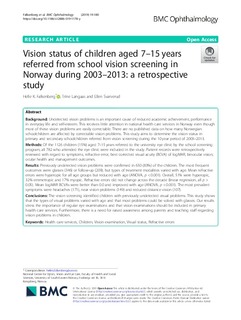| dc.contributor.author | Falkenberg, Helle Kristine | |
| dc.contributor.author | Langaas, Trine | |
| dc.contributor.author | Svarverud, Ellen | |
| dc.date.accessioned | 2019-10-22T08:28:17Z | |
| dc.date.available | 2019-10-22T08:28:17Z | |
| dc.date.created | 2019-09-06T15:43:52Z | |
| dc.date.issued | 2019 | |
| dc.identifier.citation | BMC Ophthalmology. 2019, 19. | nb_NO |
| dc.identifier.issn | 1471-2415 | |
| dc.identifier.uri | http://hdl.handle.net/11250/2623640 | |
| dc.description | Open Access This article is distributed under the terms of the Creative Commons Attribution 4.0 International License which permits unrestricted use, distribution, and reproduction in any medium, provided you give appropriate credit to the original author(s) and the source, provide a link to the Creative Commons license, and indicate if changes were made. | nb_NO |
| dc.description.abstract | Background: Undetected vision problems is an important cause of reduced academic achievement, performance in everyday life and self-esteem. This receives little attention in national health care services in Norway even though most of these vision problems are easily correctable. There are no published data on how many Norwegian schoolchildren are affected by correctable vision problems. This study aims to determine the vision status in primary and secondary schoolchildren referred from vision screening during the 10 year period of 2003–2013. Methods: Of the 1126 children (15%) aged 7–15 years referred to the university eye clinic by the school screening program, all 782 who attended the eye clinic were included in the study. Patient records were retrospectively reviewed with regard to symptoms, refractive error, best corrected visual acuity (BCVA) of logMAR, binocular vision, ocular health and management outcomes. Results: Previously undetected vision problems were confirmed in 650 (83%) of the children. The most frequent outcomes were glasses (346) or follow-up (209), but types of treatment modalities varied with age. Mean refractive errors were hyperopic for all age groups but reduced with age (ANOVA, p < 0.001). Overall, 51% were hyperopic, 32% emmetropic and 17% myopic. Refractive errors did not change across the decade (linear regression, all p > 0.05). Mean logMAR BCVAs were better than 0.0 and improved with age (ANOVA, p < 0.001). The most prevalent symptoms were headaches (171), near vision problems (149) and reduced distance vision (107). Conclusions: The vision screening identified children with previously undetected visual problems. This study shows that the types of visual problems varied with age and that most problems could be solved with glasses. Our results stress the importance of regular eye examinations and that vision examinations should be included in primary health care services. Furtherm | nb_NO |
| dc.description.abstract | Vision status of children aged 7–15 years referred from school vision screening in Norway during 2003–2013: a retrospective study | nb_NO |
| dc.language.iso | eng | nb_NO |
| dc.rights | Navngivelse 4.0 Internasjonal | * |
| dc.rights.uri | http://creativecommons.org/licenses/by/4.0/deed.no | * |
| dc.title | Vision status of children aged 7–15 years referred from school vision screening in Norway during 2003–2013: a retrospective study | nb_NO |
| dc.type | Journal article | nb_NO |
| dc.type | Peer reviewed | nb_NO |
| dc.description.version | publishedVersion | nb_NO |
| dc.rights.holder | © The Author(s). 2019 | nb_NO |
| dc.source.pagenumber | 9 | nb_NO |
| dc.source.volume | 19 | nb_NO |
| dc.source.journal | BMC Ophthalmology | nb_NO |
| dc.identifier.doi | 10.1186/s12886-019-1178-y | |
| dc.identifier.cristin | 1722426 | |
| cristin.unitcode | 222,56,2,0 | |
| cristin.unitname | Institutt for optometri, radiografi og lysdesign | |
| cristin.ispublished | true | |
| cristin.fulltext | original | |
| cristin.qualitycode | 1 | |

